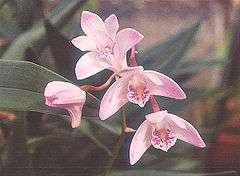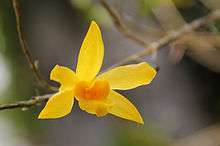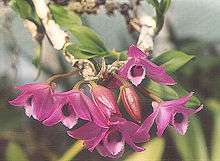Dendrobium
- For the mining town, see Dendrobium, New South Wales. For the hydroid genus, see Solanderiidae.
| Dendrobium | |
|---|---|
 | |
| Pink Rock Orchid, Dendrobium kingianum | |
| Scientific classification | |
| Kingdom: | Plantae |
| (unranked): | Angiosperms |
| (unranked): | Monocots |
| Order: | Asparagales |
| Family: | Orchidaceae |
| Subfamily: | Epidendroideae |
| Tribe: | Podochileae |
| Subtribe: | Dendrobiinae |
| Genus: | Dendrobium Sw |
| Species | |
|
About 1,200; see List of Dendrobium species | |
| Synonyms[1] | |
|
Genus synonymy
| |
Dendrobium is a huge genus of orchids. It was established by Olof Swartz in 1799 and today contains about 1,200 species. The genus occurs in diverse habitats throughout much of south, east and southeast Asia, including China, Japan, India, the Philippines, Indonesia, Australia, New Guinea, Vietnam, and many of the islands of the Pacific.[1] The name is from the Greek dendron ("tree") and bios ("life"); it means "one who lives on trees", or, essentially, "epiphyte".
In 1981, Briegar reclassified all terete-leaved Dendrobiums from Australia and New Guinea into a new genus, Dockrillia. The Winika orchid from New Zealand was formerly D. cunninghamii, but has now been moved into a monotypic genus Winika. In 1989, Clements upgraded the D. speciosum complex into individual species;[2] similarly, the D. bigibbum complex (which contains the well-known Cooktown Orchid of Australia, D. phalaenopsis) has recently been split up. However, as an illustration of the current revisions in the taxonomy of Orchidaceae these 'splits' have now been reversed and the currently accepted species, natural nothospecies are presented on Wikispecies Dendrobium. The site includes a list of references that help explain the contemporary taxonomy of Dendrobium Sw., Nova Acta Regiae Soc. Sci. Upsal. 6: 82 (1799), nom. cons.
Description
Dendrobium species are either epiphytic, or occasionally lithophytic. They have adapted to a wide variety of habitats, from the high altitudes in the Himalayan mountains to lowland tropical forests and even to the dry climate of the Australian desert.
This genus of sympodial orchids develop pseudobulbs, which vary in length from under a centimetre (e.g. Dendrobium leucocyanum) to several metres long (e.g. Dendrobium discolor), resembling canes. A few grow into long reedlike stems. Leaf bases form sheaths that completely envelope the stem. In the section Formosae (e.g. Dendrobium infundibulum), the sheaths and undersides of leaves are covered with fine short black hairs. Other species (e.g. Dendrobium senile), are covered with fine white hairs.
In selected species, the short, ovate leaves grow alternately over the whole length of the stems, in others, the leaves are bunched towards the apex of the stem (e.g. Dendrobium tetragonum). The axillary inflorescence vary in length from insignificant to 1m long, and can carry from a few (1-4) (e.g. Dendrobium nobile) to as many as 100 (e.g. Dendrobium speciosum) flowers. Deciduous species carry their leaves for one to two years then typically flower on leafless canes, while canes of evergreen species usually flower in the second year and can continue to flower for a number of years (e.g. Dendrobium densiflorum).
These orchids grow quickly throughout summer, but take a rest during winter. Dormant buds erupt into shoots from the base of the pseudobulb mainly in spring, and a few species in autumn. This is then followed by rapid growth of new roots. Reproduction is usually through seed, but a few species reproduce asexually through keikis produced along the stem, usually after flowering and sometimes as a result of injury to the growing tip.
Selected species

- Dendrobium anosmum – Unscented Dendrobium - misnomer
- Dendrobium begaudii
- Dendrobium bilobum
- Dendrobium brevicaudum– Mount Finnigan orchid
- Dendrobium bukidnonensis– Bukidnon Dendrobium
- Dendrobium bullenianum – Bullen's Orange Dendrobium
- Dendrobium candidum
- Dendrobium cariniferum
- Dendrobium ceraula – Horned Dendrobium
- Dendrobium chameleon – Chameleon-like Dendrobium
- Dendrobium chrysanthum
- Dendrobium conanthum
- Dendrobium crispilinguum
- Dendrobium crumenatum – Pigeon Orchid, Sparrow Orchid, Bag-shaped Dendrobium, "dove orchid"
- Dendrobium cuthbertsonii – Cuthbertson's Dendrobium
- Dendrobium dearei – Deare's Dendrobium
- Dendrobium erosum
- Dendrobium epidendropsis from the Philippines
- Dendrobium euryanthum
- Dendrobium fairchildae – Fairchild's Dendrobium
- Dendrobium falcorostrum – beech orchid
- Dendrobium forbesii
- Dendrobium formosum
- Dendrobium gerlandianum
- Dendrobium gibsonii
- Dendrobium goldschmidtianum – Goldschmidt's Dendrobium
- Dendrobium guerreroi – Guerrero's Dendrobium
- Dendrobium hellwigianum
- Dendrobium hercoglossum
- Dendrobium heterocarpum – Different fruits Dendrobium
- Dendrobium hymenophyllum
- Dendrobium ionopus – Violet scented Dendrobium
- Dendrobium johnsoniae
- Dendrobium junceum Philippine endemic
- Dendrobium kingianum – Pink Rock Orchid, Captain King's Dendrobium, Pink Rock Lily (sometimes separated in Thelychiton)
- Dendrobium lydiae Cootes, M.Leon & Naive, 2016 [3]
- Dendrobium lindleyi – Lindley's Dendrobium (formerly D. aggregatum)
- Dendrobium lineale
- Dendrobium lituiflorum
- Dendrobium loddigesii – Loddiges' Dendrobium
- Dendrobium macrophyllum – Large leafed Dendrobium
- Dendrobium macropus
- Dendrobium macropus subsp. howeanum – Bush Orchid
- Dendrobium milaniae native of Mount Pangasugan in the Philippine
- Dendrobium mindanaense – Mindanao island Dendrobium
- Dendrobium miyasakii – Miyaki's Dendrobium
- Dendrobium nobile – Noble Dendrobium
- Dendrobium papilio – Butterfly Dendrobium
- Dendrobium parthenium
- Dendrobium pendulum
- Dendrobium pentapterum
- Dendrobium phalaenopsis – Cooktown Orchid (formerly D. bigibbum var. phalaenopsis, D. bigibbum var. superbum) - now classified as Vappodes phalaenopsis
- Dendrobium philippinensis– Philippine Dendrobium
- Dendrobium phillippsii – Phillips' Dendrobium
- Dendrobium platycaulon – Flat Cane Dendrobium
- Dendrobium polysema
- Dendrobium profusum – Profused' Dendrobium
- Dendrobium ramosii – Ramos' Dendrobium
- Dendrobium sanderae – Sander's Dendrobium
- Dendrobium sanguinolentum
- Dendrobium schuetzei – Schuetz's Dendrobium
- Dendrobium secundum
- Dendrobium seratilabium – Serrated Lip Dendrobium
- Dendrobium sinense
- Dendrobium speciosum – Outstanding Dendrobium, King Orchid, Rock Lily
- Dendrobium taurinum – Bulls Head Dendrobium
- Dendrobium thyrsiflorum
- Dendrobium thysanophorum
- Dendrobium uniflorum – Single flowered Dendrobium
- Dendrobium velutinalabrum
- Dendrobium victoriae-reginae – Queen Victoria's Dendrobium
- Dendrobium wangliangii – May 2006 by Liang Wang (Chinese: 王亮)
- Dendrobium wenzellii – Wenzell's Dendrobium
- Dendrobium yeagerei – Yeager's Dendrobium
In horticulture
Dendrobium is commonly abbreviated as Den in horticulture. Some species are in great demand by orchid lovers. This has resulted in numerous varieties and hybrids, such as the Noble Dendrobium (D. nobile) breeds, which have greatly extended the range of colors of the original plant from the Himalayas. The flowers of Cuthbertson's Dendrobium (D. cuthbertsonii) have been reported to last up to ten months each.
Many Dendrobium species are known to vigorously remove toluene and xylene from the air.[4]
Several hybrids in this genus have been registered and named after notable persons and institutions:
- Dendrobium Bae Yong-joon
- Dendrobium Sccci 100th Anniversary
- Dendrobium Margaret Thatcher
- Dendrobium Iriana Jokowi
 Pink Dendrobium densiflorum × farmeri hybrid
Pink Dendrobium densiflorum × farmeri hybrid Dendrobium 'Mini Brown', a horticultural hybrid
Dendrobium 'Mini Brown', a horticultural hybrid Painting of a typical Dendrobium by I. V. Passmoore, probably the hybrid Dendrobium Lucky Seven
Painting of a typical Dendrobium by I. V. Passmoore, probably the hybrid Dendrobium Lucky Seven Dendrobium Margaret Thatcher
Dendrobium Margaret Thatcher_1200.jpg) Dendrobium hybrida
Dendrobium hybrida_1200.jpg) Dendrobium
Dendrobium
Other uses by humans

Some Dendrobium species are cultivated as medicinal plants.[5] The Noble Dendrobium (D. nobile) for example is one of the 50 fundamental herbs used in traditional Chinese medicine, where it is known as shí hú (石斛) or shí hú lán (石斛兰).
Many species and cultivars of this genus are well-known floral emblems and have been figured in artwork. Among the former are:
- Dendrobium formosum (Beautiful giant-flowered dendrobium) – emblem of Ranong Province (Thailand)
- Dendrobium 'Kim il Sung' (Kimilsungia) – emblem of North Korea[6]
- Dendrobium moniliforme (Sekikoku) – emblem of Matsushima, Miyagi (Japan)
- Dendrobium nobile (Noble Dendrobium) – emblem of Sikkim (India)
- Dendrobium biggibum (Cooktown Orchid, anggrek larat) – emblem of Maluku province (Indonesia) and Queensland (Australia).
- Dendrobium utile (locally known as anggrek serat) – emblem of the Indonesian province of South East Sulawesi
The Cooktown Orchid was figured on Australian stamps in 1968 and 1998, and several Dendrobium cultivars are depicted on the obverse side of the Singapore Orchid Series currency notes issued between 1967 and 1976:
- Dendrobium Marjorie Ho – S$10
- Dendrobium Shangri-La – S$500
- Dendrobium Kimiyo Kondo – S$1000
The Golden-bow Dendrobium (D. chrysotoxum), colloquially called "Fried-egg Orchid" was one of the species grown by the fictional private detective and orchid fancier Nero Wolfe, and plays a role in The Final Deduction.
References
- 1 2 Kew World Checklist of Selected Plant Families
- ↑ Clements (1989)
- ↑ New orchid species found in Philippine forest guerrilla zone
- ↑ Wolverton (1996)
- ↑ http://uses.plantnet-project.org/en/Dendrobium_(PROSEA)
- ↑ Soediono, Noes, Arditti, Joseph and Soediono, Rubismo. Kimilsungia: How an Indonesian Orchid Became a Revered Symbol in the Democratic People’s Republic of Korea After Its Name was Changed. Plant Science Bulletin 75 3 pp. 103-113
- Clements, M.A. (1989): Catalogue of Australian Orchidaceae. Australian Orchid Research 1: 1–62. PDF fulltext
- Wolverton, B.C. (1996): How to Grow Fresh Air. New York: Penguin Books.
- Lavarack, B., Harris, W., Stocker, G. (2006): Dendrobium and Its Relatives. Australia: Simon & Schuster Ltd.
- Burke, J.M., Bayly, M.J., Adams, P.B., Ladiges, P.Y.: (2008) Molecular phylogenetic analysis of Dendrobium (Orchidaceae), with emphasis on the Australian section Dendrocoryne, and implications for generic classification. Australian Systematic Botany 21: 1-14. Abstract
External links
-
 Media related to Dendrobium at Wikimedia Commons
Media related to Dendrobium at Wikimedia Commons -
 Data related to Dendrobium at Wikispecies
Data related to Dendrobium at Wikispecies - Dendrobium photos
- Multikey System for Identification of Dendrobium species
- Orchid Picture Gallery
